Volume 42, Issue 8 | February 2021
Introducing the Greater Philadelphia Pedestrian Portal

Pedestrian infrastructure -- sidewalks, curb ramps, and crosswalks -- is important to every trip, including those by car. Many of the region’s residents want and need to live in accessible and walkable communities, to be able to walk to a neighborhood park, cross the street while pushing a stroller, get to a bus stop, or be able to get from a vehicle into a grocery store while in a wheelchair.
DVRPC’s new Pedestrian Portal features a regional Pedestrian Network GIS dataset, an interactive map anyone can use to view the data, and resources that support the development of more pedestrian connections. It is a central place to learn about DVRPC’s multilayered approach to inventorying pedestrian infrastructure and helping communities build more sidewalks.
Visit walk.dvrpc.org to explore sidewalks in your community, or to edit and review the data in the areas you know well. A plan account will be available soon, for those who are involved in land use or transportation projects, so stay tuned!
Join us to Brainstorm Strategies for Connections 2050
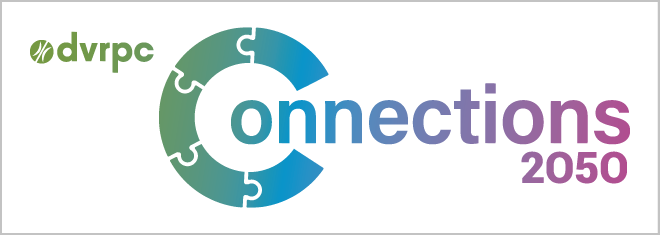
Through the visioning process held from April to July 2020, we heard from over 700 individuals about their values, concerns, and vision for the future of Greater Philadelphia. Now, join DVRPC in identifying what the region needs to do to achieve that vision by 2050.
You are invited to one or more of the following interactive workshops (pre-registration is encouraged):
Energy & The Environment
Wednesday, February 10, 2021
1:00 PM - 3:00 PM
Register
(Hosted by DVRPC’s Climate Change Adaptation Forum)
Equity & Civic Engagement
Tuesday, February 16, 2021
5:30 PM - 7:30 PM
Register
(Hosted by the Public Participation Task Force)
Economy & The Built Environment
Tuesday, February 23, 2021
10:00 AM - 12:00 PM
Register
(Hosted by DVRPC’s Regional Community & Economic Development Forum and Healthy Communities Task Force)
The Vision for 2050

At the heart of a long-range plan is a broadly shared vision for where we collectively want Greater Philadelphia to be in 30 years. This is the vision for Connections 2050:
An equitable, resilient, and sustainable Greater Philadelphia that:
- Preserves and protects the natural environment.
- Develops inclusive, healthy, and walkable communities.
- Grows a prosperous and innovative economy.
- Maintains an integrated, multimodal transportation network.
Learn more about Connections 2050 and upcoming strategies workshops: www.dvrpc.org/2050.
Tool Update: Interactive Detour Route Mapping (IDRuM)
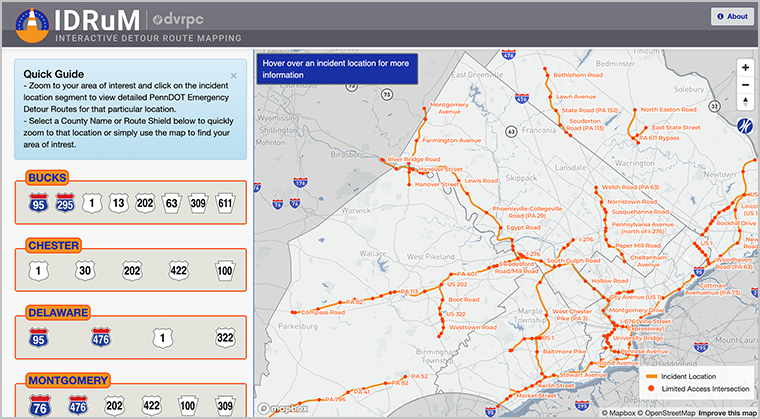
DVRPC, in partnership with PennDOT District 6, has revamped the web-based Interactive Detour Route Mapping (IDRuM) application. It organizes all existing PennDOT Emergency Detour Routes within the DVRPC region. IDRuM is not intended for real time usage by the traveling public, but for pre-planning efforts by PennDOT, first responders, planners, and/or anyone who is in need of DOT-approved detour route plans.
These pre-planned diversion routes can be used in case of an emergency or incidents that require the closures of the highway. Typically, they will divert the traveler from one interchange to the next while avoiding areas susceptible to traffic snarls and secondary traffic from events, school zones, and scheduled gatherings. They also take into account heavy trucks and avoid bridges with height and weight restrictions.
The IDRuM platform has been completely redesigned into a new manageable, easy-to-use online, GIS-based interface. IDRuM compiles the PDF detour maps into a simple "point-and-click" online application which allows the detour maps to be downloaded to be viewed, saved, and/or printed. In the past, emergency responders would have to carry with them large binders outlining alternative routes. Now with IDRum this information is readily available through the web. Check out the web application at www.dvrpc.org/Transportation/TSMO/IDRuM.
For more information, contact Paul Carafides, Manager, Traffic Management Program, Office of Transportation Operations Management, at pcarafides@dvrpc.org.
Pedestrian Counts in Philadelphia: A Year of Ups and Downs

To say 2020 was an eventful year full of ups and downs is an understatement! These ups and downs can also be seen in different patterns of pedestrian activity across the City of Philadelphia.
Pedestrian counts taken at 3rd and Market streets in Old City showed drastic variations, depending on what was happening in Philadelphia (and the world) at the time. The highest number of pedestrians (5,810) was counted on November 7, the day the 2020 Presidential election results were called. Compare that to the lowest number of pedestrians (471) at the same location on Sunday, April 26 during the stay-at-home order. See how these counts compare to other counts taken at 40th Street and Lancaster Avenue, on DVRPC’s Bicycle and Pedestrian Counts webpage.
Preparing Greater Philadelphia for Highly Automated Vehicle Deployment
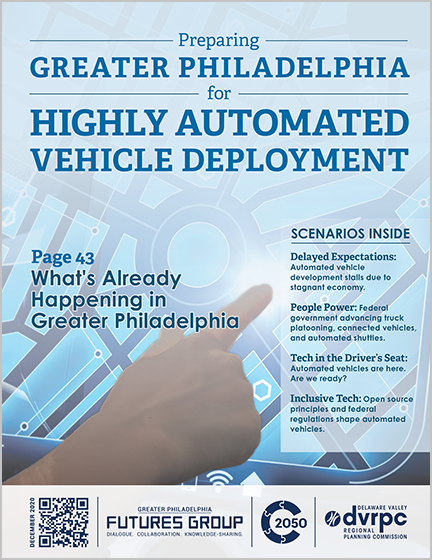
What does Greater Philadelphia need to do to be ready for highly automated vehicles (HAVs)? This new DVRPC report explores the future of transportation through the lens of vehicular automation. It reviews the technologies being used to create HAVs and where they are in their development. It then extends the Dispatches exploratory scenarios to consider different ways HAVs could roll out in the future.
Five key takeaways emerge from the analysis, including the need for a clear direction for how Greater Philadelphia residents would like HAVs to be deployed. The report recommends developing a new partnership between regional transportation agencies to better coordinate and prepare for technology deployment.
This report is a companion to Dispatches from Alternative Futures: Exploratory Scenarios for Greater Philadelphia. Learn more about Connections 2050 and how to get involved, at www.dvrpc.org/2050.
New DVRPC Products
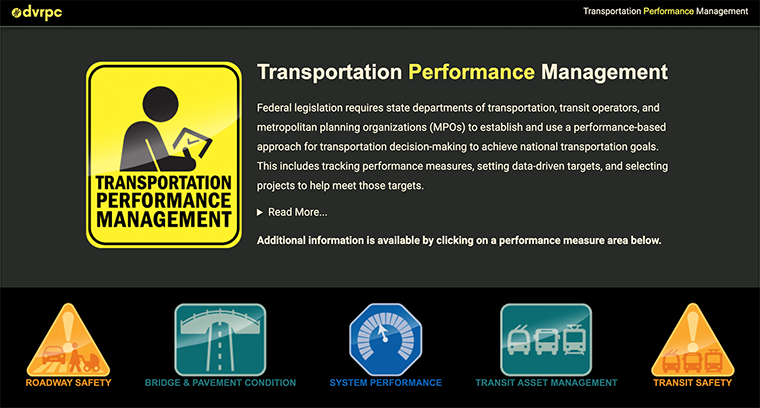
The Transportation Performance Management website tracks how our region is achieving targets in five federally mandated performance measure areas: 1) roadway safety, 2) bridge and pavement condition, 3) system performance, 4) transit asset management, and 5) transit safety. Each performance measure area includes details about the specific targets, how they’re measured, and how the region is doing.
Safe Routes To Transit: Bordentown Station proposes a series of design treatments with a focus on low-cost, high-impact interventions around Bordentown Station on New Jersey Transit (NJ Transit's) River LINE light rail. Working with a variety of partners, most notably the City of Bordentown and Burlington County, DVRPC assisted with the implementation steps to assist the municipality in funding and building a series of safety improvements for people walking and biking to the River LINE station and downtown Bordentown.
US 202 Section 200 Operations Analysis highlights the major interstate route that runs from Delaware to Maine. The study looks at methods for improving the operational efficiency of US 202 Section 200 through West Goshen Township by examining design alternatives that would benefit local residents and commuters while improving safety.
Hunting Park East Freight Access Study examined the neighborhood’s freight patterns in order to provide recommendations to the City of Philadelphia for improving the area’s industrial economic center while ensuring the safe and efficient movement of both people and goods.
DVRPC FY2021 Transportation Improvement Program (TIP) for Pennsylvania (FY21-FY24) and Addendum contains a listing of all transit, highway, bridge, bicycle, pedestrian, and multimodal projects in DVRPC’s Pennsylvania counties that seek federal funding in fiscal years 2021 to 2024. These projects are representative of the targets and goals set for the region over the next four years.
Upcoming LTAP Classes
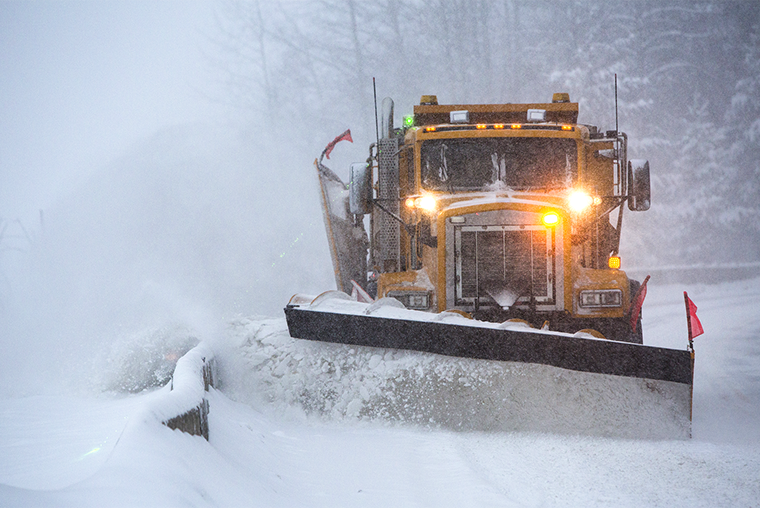
The Local Technical Assistance Program (LTAP) provides technical information and expertise to help municipal governments use transportation funds more effectively, improve road maintenance, and increase roadway safety. Upcoming virtual classes include:
Engineering and Traffic Studies
February 10-11, 2021 (5:00 PM - 7:00 PM)
Winter Maintenance 101
February 16, 2021 (8:00 AM - 12:00 PM)
Grant Management for Federal-Aid Projects
February 17, 2021 (9:00 AM - 12:00 PM)
Visit Rutgers Center for Advanced Infrastructure and Transportation and PennDOT’s LTAP website to see additional courses and register. Please contact Linda McNeffer at lmcneffer@dvrpc.org if you have any questions.